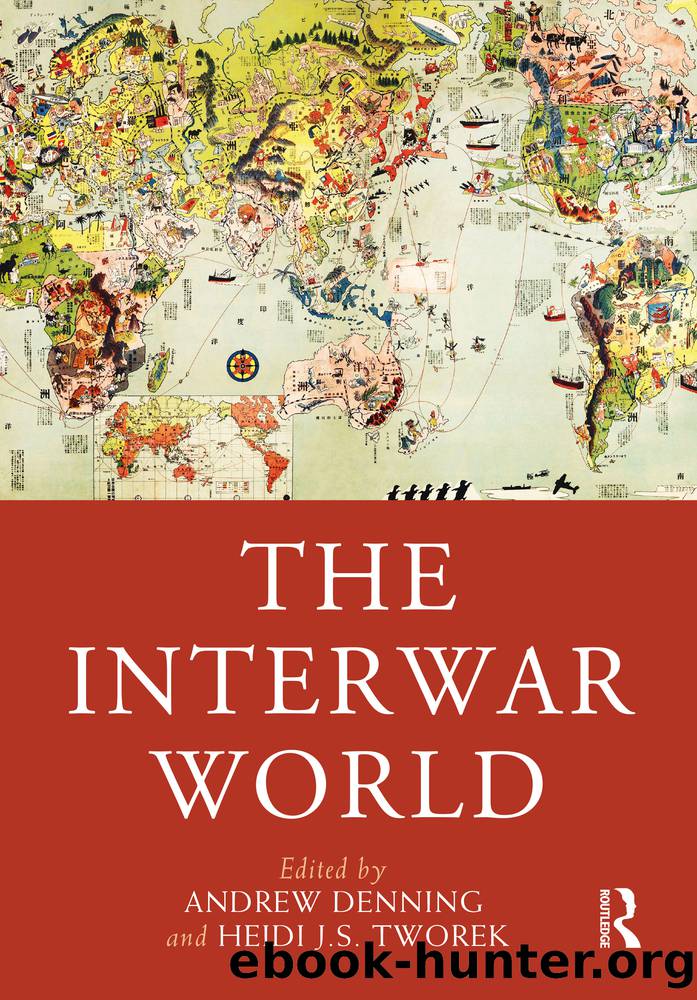The Interwar World by Andrew Denning;Heidi J.S. Tworek;

Author:Andrew Denning;Heidi J.S. Tworek;
Language: eng
Format: epub
Publisher: Taylor & Francis (Unlimited)
Published: 2024-07-15T00:00:00+00:00
The expansion of print media to new audiences was not only due to the spread of mass-circulation newspapers, but also the growing availability of cheap printing presses and relatively small-scale printing works, which enabled more producers to enter the world of print.
This expansion was underpinned by rising literacy rates and new languages of print. Literacy was a priority both for conservative governments nervous about new voting publics enfranchised during and after the First World War, as well as for revolutionaries and modernizers. Revolutionary movements designed mass education policies and programs targeting rural and worker communities. The consolidators of the Mexican Revolution (1910â1920) focused upon agrarian communities and aimed to reform technical education for manual workers in the 1920s and 1930s. Between 1934 and 1940, the number of rural schools and teachers in Mexico doubled (Britton 1973, 233). In the 1920s Chinese nationalists and modernizers formulated educational programs as part of a rural development movement and the Kuomintang, who took over government in 1927, embarked on a rural education program. By the early 1930s, the Kuomintang governmentâs mass education efforts targeted rural society primarily but focused on education for economic uplift rather than learning to read and write (Li 2021, 255). Bolshevik policy in the first two decades of Soviet rule sought to teach âliteracy and political literacy together,â as Soviet politician Grigory Zinoviev put it (Fitzpatrick 1979, 32). Between 1914 and 1928 the number of junior schools tripled, the number of trade schools more than doubled, and upper vocational schools (technicums) expanded five-fold (Fitzpatrick 1979, 62). After 1928 the Soviet state embarked upon its brutal collectivization alongside campaigns for mass education of peasants, creating a âCultural Armyâ to eradicate illiteracy.
European colonial empires developed a new interest in educational policy and literacy rates in the 1920s too. Although half-heartedly and patchily applied, France embarked upon a postwar colonial development strategy of programs that built schools in its colonies, mainly to educate people to work in an office, shop, or a trade without simultaneously challenging colonial rule. The most extensive system emerged in Vietnam, where 378,000 children were in school by 1930 (Conklin 2000, 193). Efforts by the Vietnamese Peopleâs Party to implement compulsory primary education in the 1930s raised literacy for both men and women from 0.7 million in 1931 to 1.7 million people in 1939 (Lewis 2016, 210). In French West Africa new primary schools meant that by 1930 about 37,000 pupils, 10% of them girls, were in school and in Madagascar close to a third of the 185,000 pupils were girls. The expanding colonial schooling system in British and French territories created pools of aspirational young people who expressed their views in newspapers and periodicals. Indeed, schools themselves became sites of circulation where young people eagerly consumed (sometimes clandestinely) and debated media.
Education was often targeted differently depending on gender, geography (rural areas often focused on agrarian practical education), and race (e.g., indentured South Asian laborers in the Caribbean received an agrarian practical education that did not promote literacy). This affected how communities around the world accessed and engaged with both broadcast and print media.
Download
This site does not store any files on its server. We only index and link to content provided by other sites. Please contact the content providers to delete copyright contents if any and email us, we'll remove relevant links or contents immediately.
The Vikings: Conquering England, France, and Ireland by Wernick Robert(79165)
Ali Pasha, Lion of Ioannina by Eugenia Russell & Eugenia Russell(39926)
The Vikings: Discoverers of a New World by Wernick Robert(36827)
The Conquerors (The Winning of America Series Book 3) by Eckert Allan W(36698)
Cecilia; Or, Memoirs of an Heiress — Volume 1 by Fanny Burney(32067)
Cecilia; Or, Memoirs of an Heiress — Volume 3 by Fanny Burney(31463)
Cecilia; Or, Memoirs of an Heiress — Volume 2 by Fanny Burney(31413)
Empire of the Sikhs by Patwant Singh(22773)
Hans Sturm: A Soldier's Odyssey on the Eastern Front by Gordon Williamson(18330)
The Secret History by Donna Tartt(18188)
Cat's cradle by Kurt Vonnegut(14768)
Sapiens: A Brief History of Humankind by Yuval Noah Harari(13994)
Pimp by Iceberg Slim(13787)
Talking to Strangers by Malcolm Gladwell(12887)
Norse Mythology by Gaiman Neil(12847)
Leonardo da Vinci by Walter Isaacson(12809)
Underground: A Human History of the Worlds Beneath Our Feet by Will Hunt(11842)
4 3 2 1: A Novel by Paul Auster(11800)
The Radium Girls by Kate Moore(11626)
